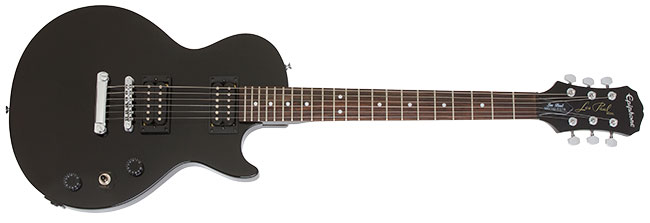A few months back a friend of mine, who's just learning to play guitar, came to me and asked if I'd build him an electric. I asked him a few questions about what he wanted, and after a brief conversation about the specifics, he just told me to surprise him. The only prerequisite was it had to be fairly inexpensive. I knew he liked Les Pauls and I just so happened to have a discarded Epiphone Les Paul Special II body lying around my basement.

I could tell by the bare wood showing in the neck pocket that it was made from mahogany (or some Asian cousin) so I figured it had potential for this project. I wasn't a huge fan of the double humbucker configuration and the control layout bugged me, not to mention the insanely thick poly finish. So I set out to strip said poly finish off, hoping to see some half-way decent looking mahogany underneath. The chemical stripper I used didn't do much, and it certainly didn't reveal any mahogany. What finish I was able to remove revealed a thin maple cap. I'm guessing Epiphone uses these for the sunburst models and also so there's less grain filling involved in the finishing steps. Anyway, I took the body over to my router planer jig, and thinned the body down, eliminating the maple top (it was barely an 1/16" thick) a I also planed down the back, just enough to get off the thick finish. After some sanding on the ROSS (Rigid Oscillating Spindle Sander) I finally got it down to the bare mahogany.

I bought a new old stock Ibanez neck I found on eBay, along with a dogear P-90. I filled in the upper part of the neck pickup cavity so that a pickguard would cover it.
The shape of the pickguard is based on the shape used on Gibson's double cut Les Pauls. This covers any seams from filling the neck pickup route and doesn't deviate from the standard pickguard shape of LP Jrs. This pickguard I cut from black ABS plastic, then lacquered. I also had to put a thin strip of wood in the bridge pickup cavity on the side closes to the bridge holes, as the P-90 cover didn't cover all the original routing. And since a P-90 is wider than a humbucker, this cavity required some minor routing on the sides.
From here, I was able to starting putting a much thinner coat of paint on the body. I didn't use any grain filler because I wanted to have the wood grain to still be visible through the finish, similar to the TV finishes Gibson used in the 50s and 60s. I used a can of white I picked up at Lowe's and misted it over the body.
Once that had dried I shot a few coats of clear coat to protect and seal the white. After that had dried, I began installing hardware on the body.
Normally, Junior models had a wraparound bridge, instead of this Tune-o-matic bridge and stop tail setup, but since the body was already drilled for this type of bridge, I used the original Epiphone bridge.
I wired up the P-90 to standard 50s Les Paul Jr. specs. 500k volume and a 250k tone controls with a .022uf capacitor.
Before I could attach the neck and string this one up, I needed to refinish the headstock on the Ibanez neck. I had begun the process before I stared painting the body and even though I used the same paint on both, the headstock didn't end up matching the color of the body. The paint I used was an off-white that when sprayed normally looked like this.

But since I misted the same paint onto the body, it looked more white then yellowed like the headstock. This is where I ran into issues. I sanded off the majority my first refinish and started again, this time with some cheap white paint I had left over from another project. If I learned nothing else from this build it was not to mix paint manufactures. After a couple coats of the white, the finish started to crinkle and crack. This white paint was reacting with what was left of the previous paint. This happened several times with the white, each time sanding down the wrinkles and trying again. Fed up with the white I decided to try black. Now with this coat, I'm not sure if it reacted with the previous coats of paint or just cracked because it was a little cold in my workshop, but it was the worst crinkling up of paint I'd ever seen.

Giving up on paint, I sanded the headstock down to the bare maple and then clear coated it. This worked out for the best because it allowed me to apply my decal (which wouldn't have showed up against a black headstock) and I didn't have to worry about color matching between the body and headstock. Here's the end result.
The headstock has some cool figure in the maple, which also sold me on going with a natural finish. Once the clear coat had cured, I was able to finally assemble the guitar. I strung it up with .10s and it's ready for delivery.














































